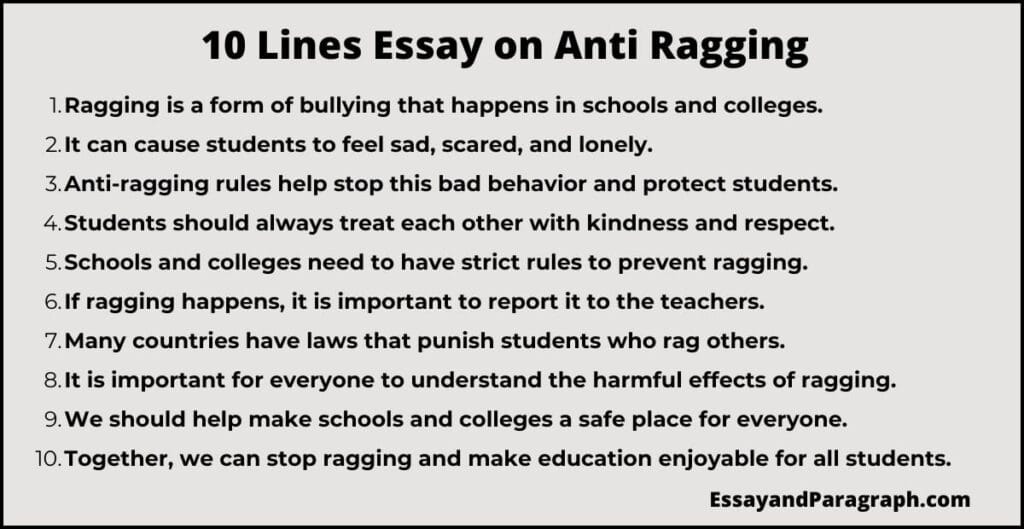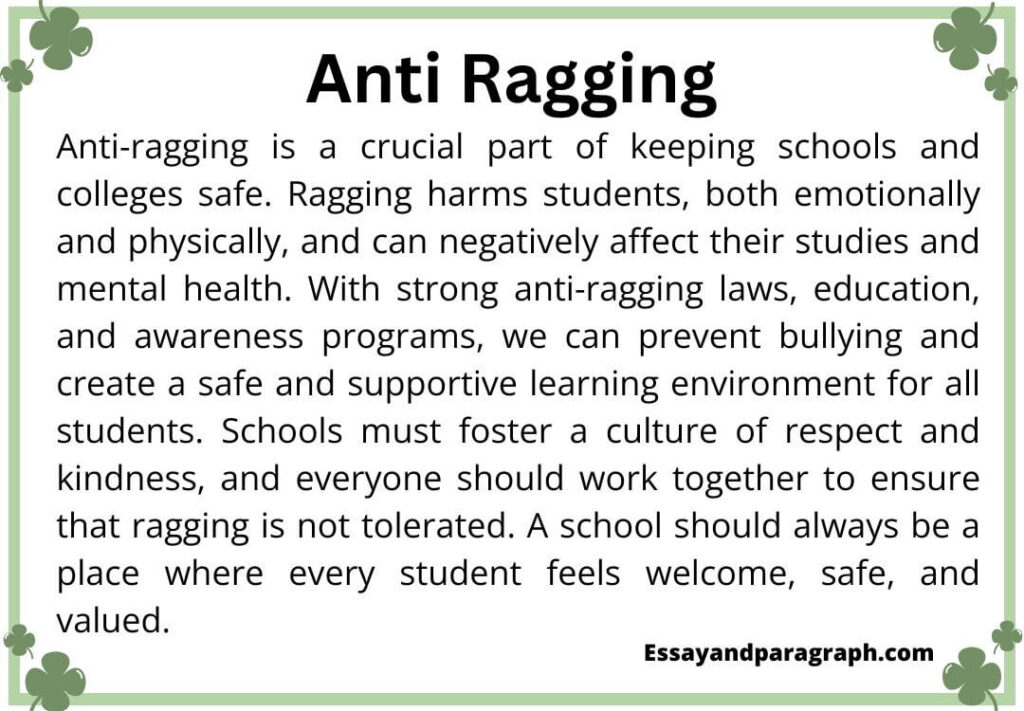Ragging is a harmful and dangerous practice often seen in schools and colleges, where older students intimidate and harass freshers. It may take different forms, including verbal, physical, or emotional abuse, and it can leave lasting scars on students. The impact of ragging is not limited to just physical injuries; it can cause severe psychological harm, leading to anxiety, depression, and a feeling of isolation. In response to this problem, anti-ragging laws and rules have been put in place to prevent this behavior and protect students. This essay will discuss the importance of anti-ragging measures, the role they play in safeguarding students, and why it is essential to eradicate ragging in educational institutions.
10 Lines Essay on Anti Ragging
- Ragging is a form of bullying that happens in schools and colleges.
- It can cause students to feel sad, scared, and lonely.
- Anti-ragging rules help stop this bad behavior and protect students.
- Students should always treat each other with kindness and respect.
- Schools and colleges need to have strict rules to prevent ragging.
- If ragging happens, it is important to report it to the teachers.
- Many countries have laws that punish students who rag others.
- It is important for everyone to understand the harmful effects of ragging.
- We should help make schools and colleges a safe place for everyone.
- Together, we can stop ragging and make education enjoyable for all students.

Short Essay on Anti Ragging (300+ words)
Ragging is a serious issue that occurs in schools and colleges, and it involves older students bullying new ones. This behavior can range from verbal insults and humiliation to physical abuse and emotional distress. The primary goal of ragging is to dominate or embarrass the freshman, often forcing them into uncomfortable situations. The consequences of ragging are severe, as it can lead to long-term emotional trauma, anxiety, and depression, affecting both academic performance and social relationships.
Anti-ragging rules play a crucial role in addressing this issue. They are designed to protect students from bullying and ensure that they feel safe and respected in their educational environment. These rules clearly state that ragging is illegal and will not be tolerated in any form. When schools and colleges enforce anti-ragging policies, it helps create a positive atmosphere where students can focus on their education without fear of harassment.
The emotional toll of ragging is often underestimated. Students who are subjected to ragging may struggle with low self-esteem, anxiety, and a fear of attending school. Anti-ragging rules not only protect students from physical harm but also preserve their mental and emotional well-being. Additionally, having clear reporting systems in place allows victims to seek help without fear of retribution, ensuring that the perpetrators are held accountable.
In conclusion, anti-ragging laws and initiatives are essential for creating a supportive and safe learning environment. Schools and colleges must work together to educate students about the harmful effects of ragging and encourage them to report any incidents. By fostering a culture of kindness, respect, and mutual understanding, we can eliminate ragging and make educational institutions places of safety and personal growth.
Long Essay on Anti Ragging (500+ words)
Ragging is a form of bullying in which senior students torment or bully newcomers in schools and colleges. This practice is widespread in many educational institutions worldwide, yet it continues to be an ongoing problem. Ragging can take several forms, including physical violence, verbal abuse, emotional manipulation, and forcing new students into embarrassing situations. While some argue that ragging is part of “tradition” or a way of breaking the ice between seniors and juniors, the reality is that ragging has devastating consequences that can affect the mental, emotional, and physical health of students.
The emotional damage caused by ragging can be severe. Many students who are victims of ragging suffer from anxiety, depression, and a lack of self-esteem. These students often feel isolated and unable to speak up due to fear of retaliation or further harassment. This fear can also lead to academic struggles, as students may find it difficult to concentrate on their studies or may skip classes altogether to avoid being targeted. The longer this bullying continues, the harder it becomes for the victim to cope with the emotional fallout, which can affect their overall development.
Anti-ragging measures have been implemented to tackle this issue and provide a safe environment for students. Schools and colleges have established clear rules that prohibit ragging and outline severe consequences for those involved in it. Anti-ragging laws, which have been enforced in many countries, include expulsion from the institution, suspension, or legal action. These measures serve as a deterrent, making it clear that ragging is not only morally wrong but also legally punishable.
To address this issue effectively, educational institutions must create a supportive environment where respect, dignity, and kindness are valued. Anti-ragging education is an essential part of this process. By teaching students about the harmful effects of ragging and encouraging them to treat each other with respect, schools can help prevent incidents of ragging before they even occur. This education should start at a young age, and students should be encouraged to speak up if they see any form of ragging taking place. The importance of kindness and respect should be emphasized both inside and outside the classroom.
The role of teachers and school authorities is crucial in preventing and addressing ragging. Teachers and counselors should be trained to identify signs of ragging and take immediate action to stop it. Schools can also provide counseling services to students who have been victims of ragging, ensuring they receive the necessary emotional support. Additionally, schools can set up anonymous reporting systems that allow students to report incidents of ragging without fear of being identified.
In addition to these internal measures, anti-ragging laws enforced by the government provide a layer of legal protection for students. These laws make it clear that ragging is unacceptable and that perpetrators will face legal consequences. They help to create a society where students do not have to fear bullying and where educational institutions are safe spaces for learning and growth.
In conclusion, anti-ragging laws and policies are vital to protecting students from harm. Schools and colleges must continue to educate students about the importance of kindness and respect and create environments where ragging is not tolerated. Through strong anti-ragging measures, awareness programs, and support systems, we can ensure that every student feels safe, valued, and respected in their educational journey.

FAQs about Anti Ragging
What is ragging?
Ragging is a form of bullying where older students harass or torment new students. It can include physical or verbal abuse and can cause emotional harm to the victim.
Why is anti-ragging important?
Anti-ragging is crucial because it helps prevent bullying, protects students from harm, and creates a safe environment for learning. It also supports the emotional and mental well-being of students.
How can we stop ragging in schools?
We can stop ragging by setting strict rules against it, educating students about its harmful effects, and encouraging them to report any incidents of ragging to teachers or authorities.
What should a student do if they are being ragged?
If a student is being ragged, they should immediately report it to a teacher or school counselor. It is important not to keep the problem to themselves and to seek help.
What are the consequences of ragging?
The consequences of ragging can be very serious. Students who rag others can be expelled from school, face legal action, or even be arrested. The consequences aim to make schools safer for everyone.
How can schools prevent ragging?
Schools can prevent ragging by educating students about respect, kindness, and the dangers of bullying. Schools can also have systems for reporting ragging and offer counseling to students who need support.
Top 10 Quotes on Anti Ragging
- “Ragging destroys the spirit of learning. Let’s end it together.”
- “Respecting others is the key to building a safe school.”
- “A bully may bring fear, but kindness brings strength.”
- “Say no to ragging; say yes to kindness.”
- “In a world full of learning, bullying should never exist.”
- “No one should feel unsafe at school. Let’s stop ragging!”
- “True education is about love, kindness, and respect.”
- “Ragging is a scar; kindness is the cure.”
- “Every student deserves a safe place to learn.”
- “Stop ragging, start respecting.”
Summary on Essay on Anti Ragging
Ragging is a harmful practice that causes emotional and physical damage to students. Anti-ragging laws are important because they protect students and create a safe learning environment. By treating each other with respect and kindness, we can prevent ragging and make schools a better place for all students. Schools should educate students about the importance of anti-ragging and encourage them to speak up when they see ragging happening. Together, we can make a difference and ensure that no student feels unsafe or humiliated in school.

Summary on Essay on Anti Ragging
Anti-ragging is a crucial part of keeping schools and colleges safe. Ragging harms students, both emotionally and physically, and can negatively affect their studies and mental health. With strong anti-ragging laws, education, and awareness programs, we can prevent bullying and create a safe and supportive learning environment for all students. Schools must foster a culture of respect and kindness, and everyone should work together to ensure that ragging is not tolerated. A school should always be a place where every student feels welcome, safe, and valued.










